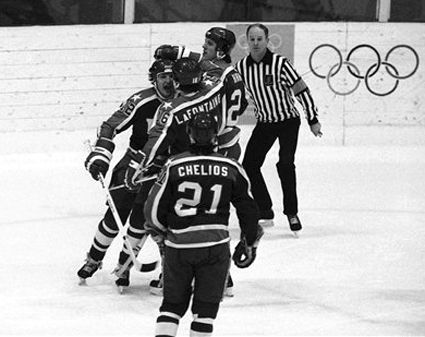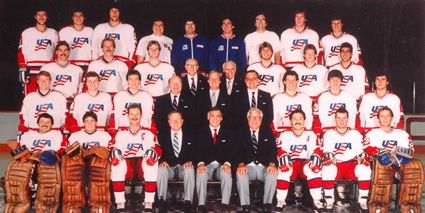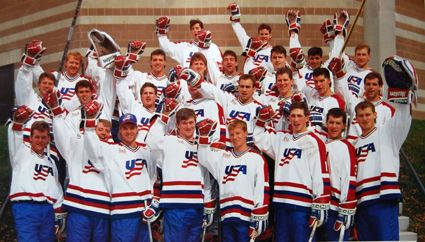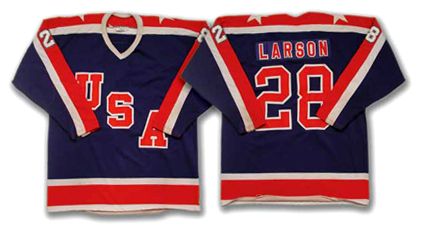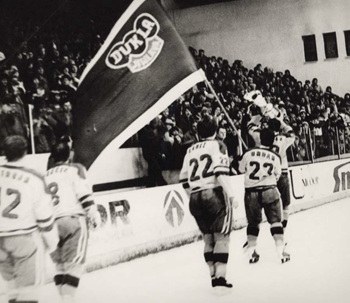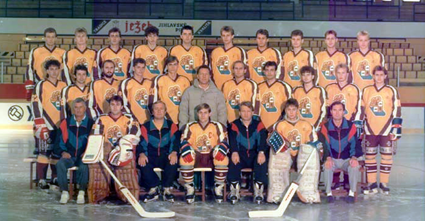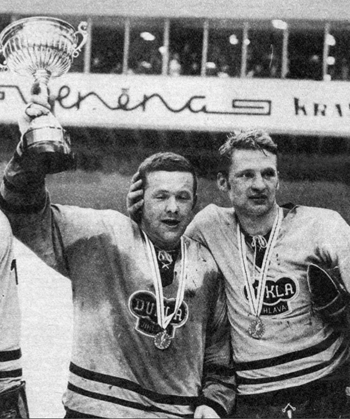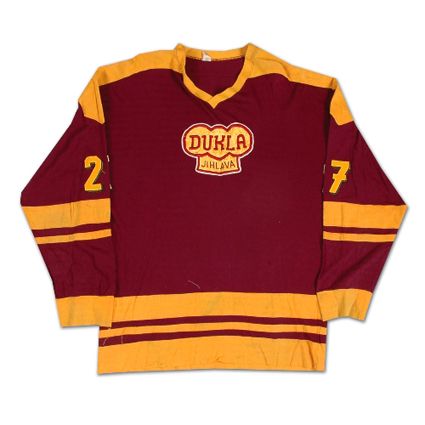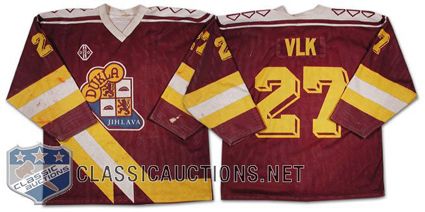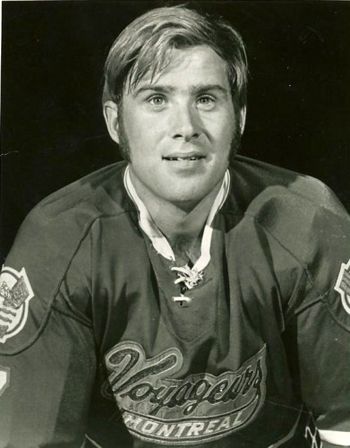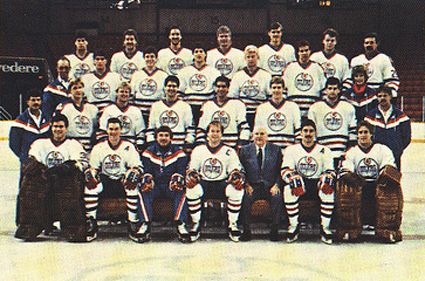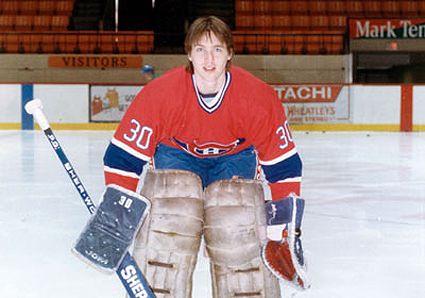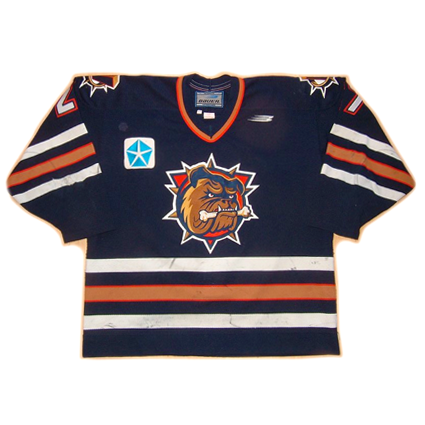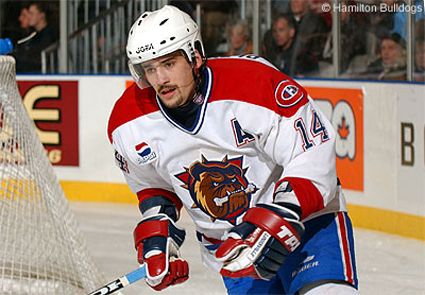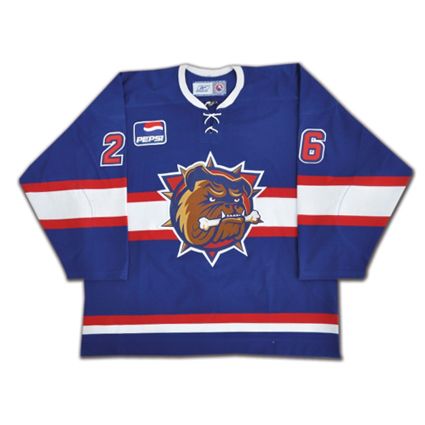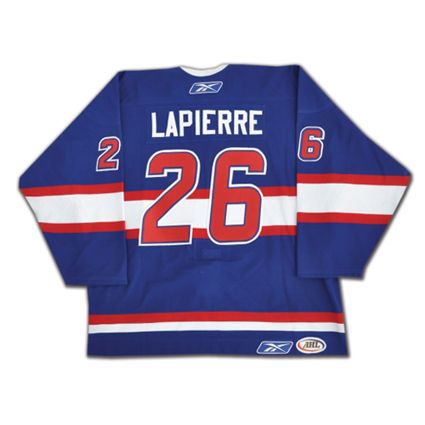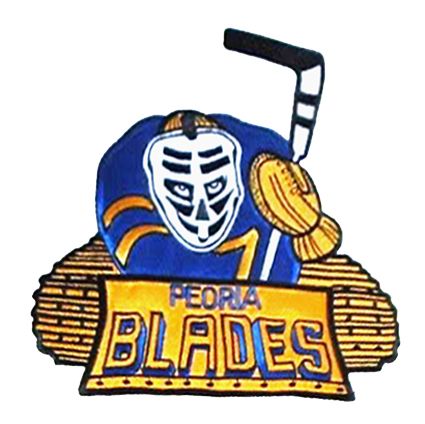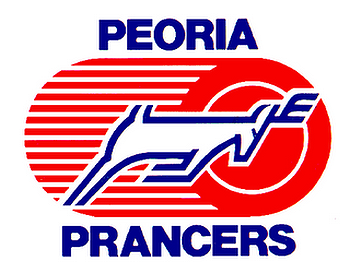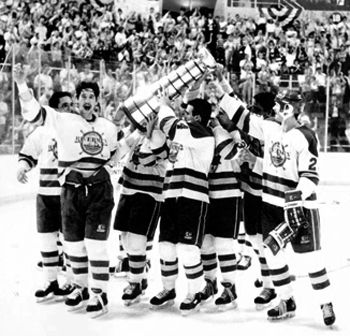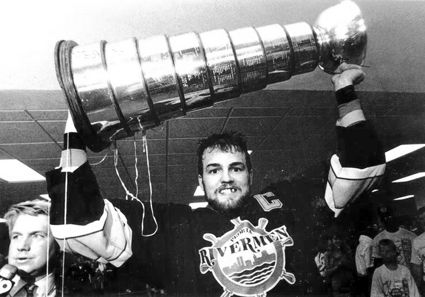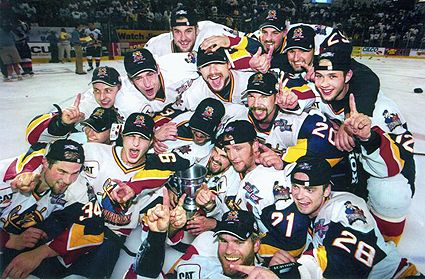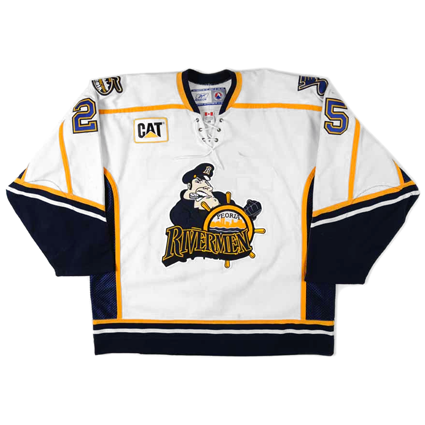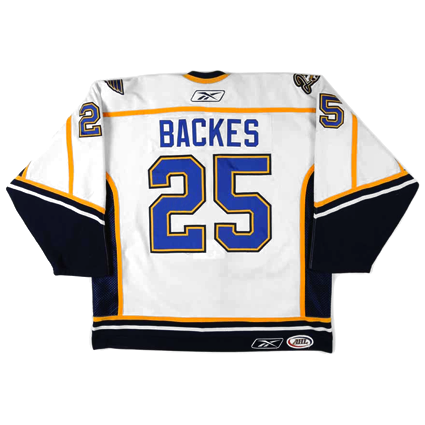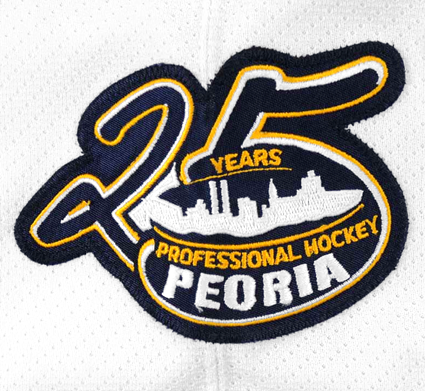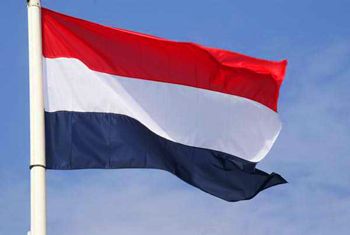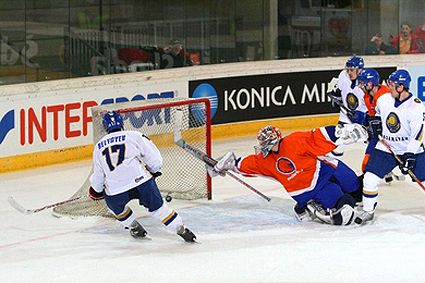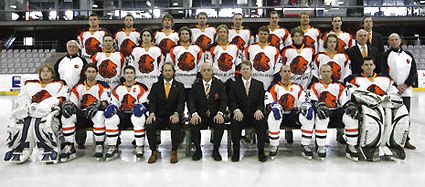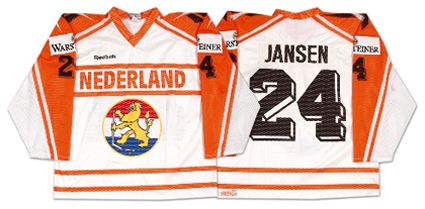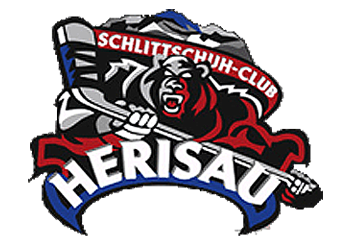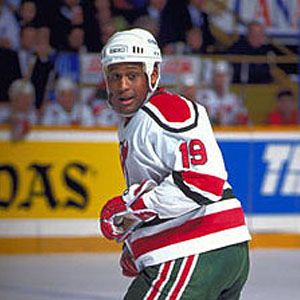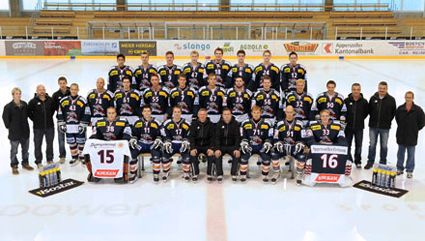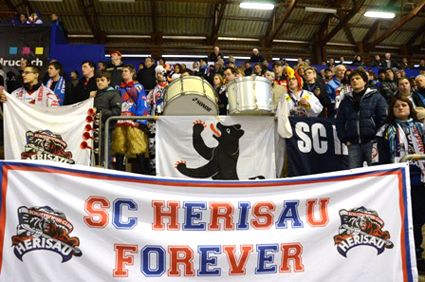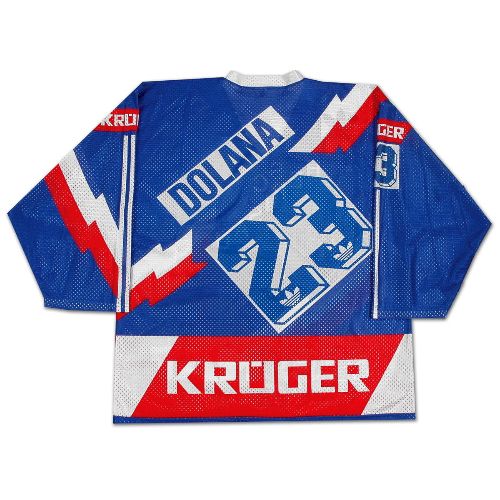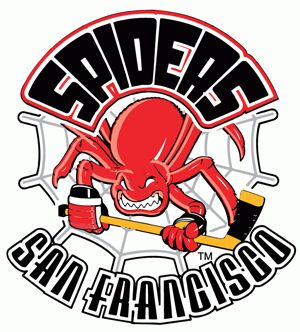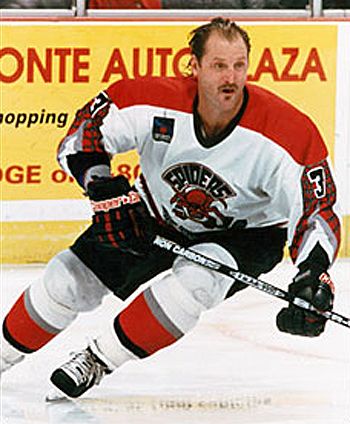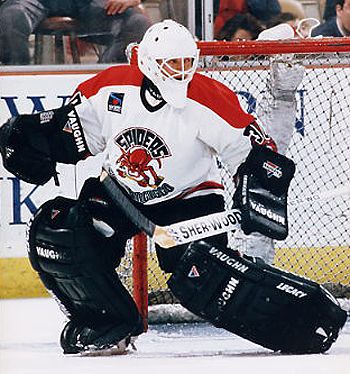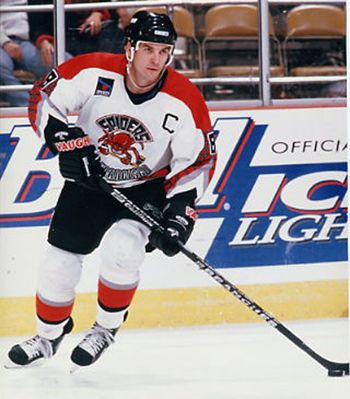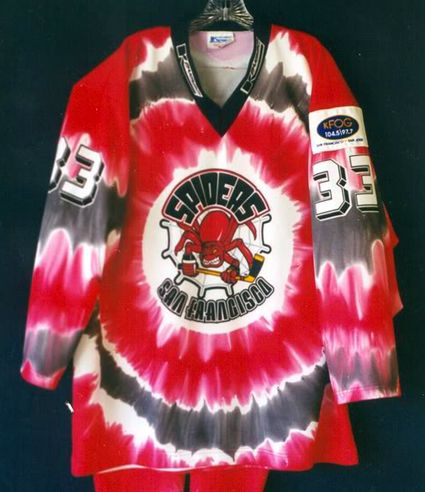Saturday, July 28, 2012
1981 United States National Team Reed Larson Jersey
July by the Numbers jersey #28 sees a return to the Land of the Free and the Home of the Brave.
Even non-hockey fans know of the Miracle on Ice when the United States won the gold medal at the 1980 Olympics under the brilliant training and tactics of the late Herb Brooks, who took a team of college amateurs into battle against the dominant veterans of the Soviet Union.
What followed was not so memorable...
The 1981 World Championships resulted in a 5th place finish, followed by a Semifinal loss to Canada at the 1981 Canada Cup, which preceded the disaster that was the 1982 World Championships, where a 0-6-1 record saw them relegated to the B Pool for 1983. The Americans won the B Pool in their first try, earning a promotion to the A Pool.
There were no World Championships in 1984, as that was an Olympic year, with the games contested in Sarajevo, Yugoslavia and expectations for the Americans were certainly high going into the tournament, but reality set in quickly as the US lost it's opening game to Canada by a score of 4-2, followed by a lackluster loss to Czechoslovakia two days later by a score of 4-1. Desperately needing a win, the best they could muster was a 3-3 tie against tiny Norway after being outshot 37-27, leaving them with a single point from three games. The US rebounded with a 7-3 win over Austria, but, already eliminated closed out their tournament with another tie, this coming against Finland. The United States finished with a 1-2-2 record, scoring 16 goals while giving up 17, winding up classified a disappointing 7th. Members of the team included future stars Chris Chelios, Al Iafrate, Pat Lafontaine and Ed Olczyk.
Chris Chelios joining Pat Lafontaine and their US teammates to celebrate a goal in 1984
Later that fall, the 1984 Canada Cup saw the United States get off to a strong beginning with a 3-1-1 record in the Round Robin portion, but Sweden ended their tournament with a resounding 9-2 decision.
The 1984 US Canada Cup Team
The 1985 World Championships were a bright spot for the US, as they finished second in Group A with a 4-2-1 record to advance to the Final Round, but dropped all three games to Canada, Czechoslovakia and the Soviet Union to miss out on the medals with a final classification of 4th.
5 losses in 7 games sank the American hopes at the 1986 World Championships and a similar result followed in 1987.
The 1987 Canada Cup was a disappointment, as the US lost 3 of 5 games, missing out on the Playoff Round entirely.
They hoped for better at the Olympics in 1988, as the games were in more familiar territory in North America - Calgary, Alberta. A more favorable schedule saw them begin with a confidence building 10-6 pounding of Austria to open their tournament, but once more the Czechoslovakians exposed the American defenses with a 7-5 win. There would not be another miracle in 1988, as the Soviet Union, in their first Olympic meeting since 1980, duplicated the Czechs with a 7-5 win. Norway fell 6-3, as expected, but any hope of advancing to the Final Round was dashed when the US fell flat against West Germany 4-1, to finish 2-3 and find themselves classified 7th once more. Members of this team included familiar names like Mike Richter, Brian Leetch and Kevin Stevens.
The 1988 US Olympic Team
The 1989 World Championships saw the US finish 6 out of 8 with a 2-4-1 record before they improved to a 5th place in 1990, winning 3 but losing 4.
In 1991, the United States gutted out a 4-1 win over Czechoslovakia following an opening 4-3 loss to Canada. They took a point away from their game with Sweden after a 4-4 tie, but the hammer of reality came down upon them with great vengeance and furious anger when the Soviet Union won 12-2. Still, more points arrived with a 4-2 defeat of Switzerland, a 4-4 tie against Germany and a 2-1 win over Finland to put the US into the Final Round, where they once again could not compete, losing to the Soviets 6-4, Sweden 8-4 and Canada 9-4 to again place out of the medals.
The Canada Cup returned in the fall, and the US started out with a 6-3 win over Sweden, followed by a 6-3 loss to Canada, a 4-2 win over Czechoslovakia and 2-1 defeat of the Soviet Union and a 4-3 win over Finland to finish second in the Round Robin portion. Finland fell easily 7-3, but hosts Canada won the Canada Cup with 4-1 and 4-2 wins in the best-of-three final. Like the Stanley Cup playoffs, the winner receives a trophy and no medals were awarded.
Albertville, France was the location of the 1992 Olympics and the US found themselves in the weaker of the two groups, avoiding Canada, Czechoslovakia and the Unified Team, made up of former members of the Soviet Union. They took full advantage of their schedule, reeling off wins against Italy 6-3, the reunited Germany 2-0, Finland 4-1 and Poland 3-0 before a final tie against Sweden 3-3, which gave them first place in Group A and a favorable draw against France in the Quarterfinals. The US took care of business 4-1 but fell to the Unified Team 5-2, which sent them to the bronze medal game, where the deflated Americans were soundly handled by Czechoslovakia 6-1 for a final classification of 4th following their initial run of success. Their roster boasted Bret Hedican, Shawn McEachern and Keith Tkachuk.
The 1992 US National Team
Later in the spring, the 1992 World Championships saw the US advance to the Quarterfinals, only to be slammed by the Czechs 8-1. 1993 was a repeat, advancing to the Quarterfinals before losing 5-2 to Sweden.
In order to get the Winter Olympics off of the same schedule as the Summer Olympics, the next Games were held two years later in 1994 in Lillehammer, Norway. The first game for the United States set the tone for what was to follow, as the US came away disappointed following a 4-4 tie with France. Again, their game against Slovakia resulted in another deadlock, this one 3-3. While they would certainly have preferred a win, taking away a point from their 3-3 tie against Canada was somewhat less disappointing. A 6-3 defeat at the hands of Sweden put them in peril, but they US took full advantage of Italy to move on to the Final Round after a 7-1 win. Their medal hopes came to an abrupt end with a 6-1 hammering at the hands of Finland. Two additional losses to Czechoslovakia (5-3) and Germany (4-3) in the Classification Round saw the US classified as 8th. Well known names from the 1994 team were University of Maine teammates Mike Dunham and Garth Snow, Peter Laviolette and Brian Rolston.
The 1994 US Olympic Team
1994's World Championships had the US advance to the Quarterfinals with a winning 3-2 record, followed by a stunning 3-1 win over Russia, but again, a 8-0 pounding by Finland ruined the joy created by their win over the Russians. With a bronze medal on the line, once again the US did not answer the bell, taking the shine off their tournament with a 7-2 loss to Sweden.
United States hockey was now on the upswing as a new generation of players were now on the scene, and Group 2 of the 1995 World Championships went to the Americans with a 3-0-2 record. Their reward? A matchup with Canada, who had stumbled in Group 1 (finishing behind Italy and France), but came alive in a 4-1 win over the US.
The 1996 World Championships began as expected, as the US defeated Austria, Germany and Slovakia, but lost to Russia and Canada. Still, it was enough to advance again to the Quarterfinals, where they surprised many with a 3-2 victory over Sweden.
While Czechoslovakia dominated them with a 5-0 win in the Semifinals, this time the United States regrouped and earned their first medal in international competition since the 1980 Olympics with a 4-3 win over Russia when 1994 Olympian Rolston scored at 4:48 of overtime. In addition to being the first medal of any kind for the US in 26 years, it was their first medal at the World Championships in 34 years, all of which puts the medal won in 1980 into a greater perspective, as the Americans were not regular medalists either prior to or after the 1980 Olympics. In fact, they were in Pool B of the World Championships as recently as 1974 before rising to their unexpected and truly memorable gold in 1980.
Today's featured jersey is a 1981 United States National Team Reed Larson jersey. This style was worn by the United States in the 1981 Canada Cup tournament and was very similar to the template worn by the Winnipeg Jets, and to some degree the Toronto Maple Leafs, with it's full length arm stripes in red trimmed with white, which is repeated to great effect along the waist.
Simple stars on the shoulders give it a touch of patriotism and the diagonal USA cresting is in the classic style of the New York Rangers, making for a simple, effective and attractive design has has stood the test of time with ease.
Labels:
USA
Friday, July 27, 2012
1986-87 Dukla Jihlava Petr Vlk Jersey
July by the Numbers returns to communist-era Czechoslovakia for jersey #27.
Founded in 1956 while Czechoslovakia was now under communist rule in the aftermath of World War II, HC Dukla Jihlava would see it's first success arrive in 1965 when they captured the prestigious Spengler Cup for the first time and would repeat as champions again in 1966.
Buoyed by that success, Dukla Jihlava (from 80 miles southeast of Prague) began a run of dominance in the Czechoslovak First Ice Hockey League that would see a run of six consecutive championship titles beginning in 1967 and stretching through 1972 aided by the fact the team was affiliated with the Czech military in much the same way the Soviet Union's Central Red Army was, which gave them first choice of many of the best players in the country, as once a players was identified as a high level player, they could simply be drafted into the army and assigned to Dukla Jihlava.
The name "Dukla" is in memory of the Battle of the Dukla Pass, which took place in the Carpathian Mountains throughout September and October of 1944 in which over 20,000 Soviet and 6,500 Czechoslovak troops were killed and over 93,000 combined were wounded as they attempted to drive the Nazis from Slovakia by entering the region through the mountains from Poland to the north. Many sports clubs in Czechoslovakia which had connections to the military were named Dukla after the battle, several of which in varying sports still retain the name today, particularly Dukla Jihlava in the Czech Republic and HK Dukla Trencin from Slovakia in ice hockey.
The first championship club in team history,
the 1966-67 Dukla Jihlava squad. Someone tell the guy
in the center of the back row to take his helmet off.
Not satisfied with dominating their domestic league, Dukla placed second in the European Champions Cup to fellow Czech side ZKL Brno and won another Spengler Cup in 1968 to cap off a memorable year. They later finished as runners up to the dominant Soviet Club Central Red Army in the Champions Cup in 1971.
The 1971-72 Dukla Jihlava team, winners of the the sixth consecutive championship
In 1973, their streak of six Czech titles came to an end with a runner up finish, but Dukla eased some of that disappointment with another European Champions Cup runner up position, again to Central Red Army.
They returned to their winning ways back home in 1974 with their seventh First League title. A fourth second place in the Champions Cup followed in 1975 and the era of Dukla's domination wound down with third places in the domestic league in 1975 and 1976 and second place finishes in 1977, 1979 and 1980.
Quickly rising back to the pinnacle once more, their eighth Czechoslovak title came in 1982 followed by their fifth Spengler Cup later that same year. They then embarked on another streak of First League dominance, as consecutive championships followed in 1983, 1984 and 1985. Coinciding with their latest run of championships, Dukla had two more runner up finishes in the European Champions Cup in 1983 and 1984 to the dominant Soviet Central Red Army (who would win 20 cups in the 22 years from 1969 to 1990).
Celebrating their championship title in 1985
Their second streak of championships would come to a close with runner up finishes in 1986 and 1987 followed by a third place in 1988 but they would rebound with their 12th First League title in 1991.
The most recent championship winning team from 1990-91
Notable players to have skated for Dukla include the father of NHLer Bobby Holik, Jaroslav Holik and the father of NHLer Ladislav Smid, Ladislav Smid Sr. Also of note was Jan Suchy played for Dukla from 1963-64 to 1978-79 and was the first recipient in 1969 of the Golden Hockey Stick award given to the top Czech hockey player annually. He won the award again in 1970, as did legendary goaltender Dominik Hasek, who played his final season in Czechoslovakia in 1989-90 with Dukla Jihlava prior to coming to North America to embark in his NHL career. Igor Liba and Bedrich Scerban also won the award while with Dukla.
Ladislav Smid, Sr. and Jaroslav Holik - champions in 1967-68
Since their glory days during the time of communism, Dukla Hilava has found life in the capitalist present increasingly tough as the profound change in the political world has leveled the playing field, taking away the inherent advantages of support by the Czech military.
Since the breakup of Czechoslovakia in 1993, Dukla first played in the Czech Extraliga but were relegated to the Czech 1. liga in 1999 for a period of five seasons before earning a promotion back to the top for one season before being relegated immediately in 2005 and are again seeking a promotion to the top level once more.
Today's featured jersey is a 1986-87 Dukla Jihlava Petr Vlk jersey. Seemingly every team in the world had advanced to polyester air knit or ultrafil jerseys by the late 1980's but this Dukla Jihlava sweater is stuck in the past, looking like something from the mid-70's as it remains a knit jersey with a lace-up collar.
In the classic Czech style, it has a large, wide block, somewhat thin font for the numbers with a drop shadow that really fills up the back of a jersey like no other countries does. Of note, and something that we absolutely love, is the bar across the 7 in the oh-so-very Eastern European style. One of our earliest hockey memories is viewing the 1972 Olympics and seeing the mysterious communists from Czechoslovakia in action for the first time and seeing a "barred 7" for the first time and thinking, "They're so foreign, they even draw their numbers different!"
photo courtesy of Classic Auctions
Bonus jersey: Today's bonus jersey is a 1990-91 Dukla Jihlava Petr Vlk jersey. Skip ahead four seasons and we find Dukla Jihlava has quickly caught up to the state of the art European jersey style as their jerseys are now made by Tackla of polyester mesh with all the graphics fully sublimated, which allows for the much more intricate and detailed coat of arms team crest and the diagonal stripes across the chest.
Gone are the classic numbers in the large "Czech style", replaced by the standard Tackla 3-D block numbers as most often seen in the Olympics and World Championships from 1989 to 1995.
photo (quite obviously) courtesy of Classic Auctions
Today's video section brings you what is declared as the "best ice hockey match ever" between VSZ Kosice and Dukla Jihlava. Let's go to the video tape (in two parts) and see if it lives up to it's advance billing...
Rock on! Na-na-na-nana!
Labels:
Dukla Jihlava
Thursday, July 26, 2012
2006-07 Hamilton Bulldogs Maxim Lapierre Jersey
July by the Numbers returns to Canada for jersey #26.
The story of the Hamilton Bulldogs is an odd timeline of franchise movement, yet stability at the same time.
Their story begins in 1969-70 with the formation of the Montreal Voyageurs of the American Hockey League as the top minor league affiliate of the Montreal Canadiens. After two brief seasons the franchise was relocated for the first time, when they became the Nova Scotia Voyageurs, where they enjoyed a long run, lasting from 1971 through 1984.
Future Canadiens star Ken Dryden with the Voyageurs in 1970-71
When the Nova Scotia Voyaguers moved for the second time, becoming the Sherbrooke Canadiens for the 1984-85 season, the Edmonton Oilers arrived on the scene to immediately fill the void left by the departing Voyageurs, naming their new club the Nova Scotia Oilers.
The 1985-86 Nova Scotia Oilers
The Oilers relocated to Cape Breton after four seasons, retaining the Oilers name and remained there through the 1995-96 season.
Meanwhile, the Sherbrooke Canadiens existed for five seasons before moving for the fourth time, this time to Fredericton for the 1990-91 season.
#30 Patrick Roy of the Sherbrooke Canadiens led
the team to the AHL championship in 1984-85
The Oilers once more relocated their AHL franchise, the former Cape Breton Oilers, moving them to Hamilton, Ontario at the west end of Lake Ontario. They had now finally become the Hamilton Bulldogs, and were set to begin play with the 1996-97 season while wearing blue and copper jerseys of the parent Edmonton club, only with the Bulldog logo. While their first regular season was a forgettable 28-39-9-4 campaign, which saw them finish 15 out of 18 teams, it was enough to qualify for the AHL playoffs, as a whopping 16 of the 18 teams made the postseason.
They drew the Saint John Flames in the first round, who they defeated in five games to advance to play the St. John's Maple Leafs, winning the series with a 3-0 shutout on the road in Game 7. Now on a roll, they then drew the Albany River Rats and proceeded to win Games 1 and 2 on the road to eventually win the series in five games to find themselves in the Calder Cup Finals despite the dismal regular season record! They eventually fell in five games to the Hershey Bears, who had finished 32 points higher than them in the standings. Despite coming up short, their unexpected playoff run was a great way to kickstart the new franchise for the fans in Hamilton.
A Bulldogs jersey from the 1996-97 to 2002-03 "Oilers" era
The next two seasons saw the Bulldogs finish with winning records and make it to the second round of the playoffs. At the same time, the Canadiens franchise in Fredericton was on the move yet again, with their fourth relocating sending them to Quebec City where they became the Quebec Citadelles for the 1999-00 season.
The Bulldogs, meanwhile, continued on, making the playoffs again in 2000, suffering a down year in 2000-01 when they missed the postseason for the first time since their arrival in Hamilton, but rebounded with a 37-30-10-3 record followed by a strong playoff push, which saw them face off against the Citadelles, whom they swept in three games, including the first two on the road. They then ousted the Hartford Wolf Pack in five before losing to the Bridgeport Sound Tigers in the Semifinals in a series which went to the full seven games.
Perhaps by now you were wondering why all the documentation of the Canadiens AHL franchise history when the Bulldogs had by now six seasons under their belts. The answer lies in a most unusual arrangement, where the Canadiens pulled the plug on the Citadelles in Quebec, and merged their franchise with the Bulldogs operation in Hamilton, now sharing the affiliation with the Edmonton Oilers.
The combined roster proved to be a powerful one in 2002-03, loaded with many recognizable future NHLers, such as leading scorer Jason Ward, Michael Ryder, Jarret Stoll, Tomas Plekanec, Marc-Andre Bergeron, Marcel Hossa, Fernando Pisani, Mike Komisarek, Francois Beauchemin, as well as veterans Mariusz Czerkawski and Donald Audette while the goaltending was a trio comprised of Mathieu Garon, Eric Fichaud and Ty Conklin. The stacked lineup dominated the AHL, finishing first overall with 110 points and made it all the way to the finals before losing in a seven game final to the Houston Aeros.
The complicated tale of the Bulldogs actually got less complicated in 2003-04, as the Oilers created a new franchise, the ill-fated one season only Toronto Roadrunners, leaving the Bulldogs to the Canadiens from 2003-04 onward, which naturally led to new jerseys to reflect the Canadiens affiliation.
A Montreal inspired Bulldogs jersey
After two winning seasons, the Bulldogs went on a roller coaster ride unlikely to have ever been duplicated, as they missed out on the playoffs in 2005-06 following a moderate 35-41 season. In 2006-07, they rebounded with a 43-28-3-6 mark, easily qualifying for the postseason.
There, they defeated the Rochester Americans and Manitoba Moose in six and the Chicago Wolves in five to reach the finals, where they defeated the Hershey Bears in five games to win the Calder Cup for the first time in style following three consecutive wins in front of their home fans one season after missing the playoffs.
The 2007 Calder Cup champion Hamilton Bulldogs
Unfortunately, the roller coaster wasn't through with the Bulldogs, as the now 29 team AHL was highly competitive in 2007-08, and despite the Bulldogs winning record of 36-34-3-7, it was not enough to qualify as one of the still 16 playoff teams, which saw the current champions out of the running to defend their title.
Of late, the Bulldogs have been very competitive, winning 52 games in 2009-10 on their way to a franchise record 115 points and an appearance in the Calder Cup Semifinals. They also returned to the Semifinals in 2010-11 for back to back deep playoff runs before missing the postseason in the most recent season, their 16th in Hamilton following a long history of franchise shifting and relocation.
Today's featured jersey is a 2006-07 Hamilton Bulldogs Maxim Lapierre jersey. Following the departure of the Oilers from Hamilton in 2003, the club entered a golden age of highly attractive jerseys based on the timeless Canadiens jersey template, which was put to great effect in both the traditional Canadiens red, as well as blue, such as in the case of today's featured jersey.
The Canadiens derived sweaters lasted just four years through the 2006-07 season, after which the time of those gorgeous Bulldogs jerseys sadly came to an end with the arrival of the Reebok Edge jerseys and their vertical piping in 2007-08.
The Bulldogs jerseys, the red ones in particular, were a real treat, as at first glance the casual viewer would naturally assume it was simply a Montreal Canadiens jersey (particularly when they used an identical number font), but closer inspection and attention to detail would reveal the bold Bulldogs logo on the chest, rewarding the attentive viewer.
Today's featured video is the Bulldogs finest moment, winning their 2007 Calder Cup championship.
Labels:
Hamilton Bulldogs
Wednesday, July 25, 2012
2006-07 Peoria Rivermen David Backes Jersey
July by the Numbers visits the Land of Lincoln for jersey #25.
The history of hockey in Peoria, Illinois begins with the Peoria Blades of the Continental Hockey League, who had a ten year run from 1972-73 until 1981-82 and sported one of the worst logos on hockey history, apparently drawn by the owner's 9-year-old with a set of felt tip pens, of a goalie sitting on tracks behind a bulldozer blade in reference to construction equipment manufacturer Caterpillar, headquartered in Peoria.
The next team to call Peoria home saw a serious upgrade in the quality of the logo, but not the team name, as the new club was christened the Peoria Prancers, with the name coming from one of Santa Claus' reindeer of all things. A genuinely dreadful name and a heavy price to pay for the apparently required alliteration. Despite the name, the logo makes the best of the subject matter and is quite dynamic with nice visual appeal, clearly executed by a professional designer this time out.
The Prancers became members of the International Hockey League, also a step up from the semi-professional CHL of the Blades, beginning in 1982-83. After two seasons of poor play, failing to qualify for the playoffs either time, the franchise changed it's name to the Peoria Rivermen following a name the team contest for the 1984-85 season following a change in ownership.
Led by Doug Evans' 97 points and Mike Prestige's 42 goals, the newly renamed club shot to the top of the standings with a 48-25-9 record behind the goaltending of former NHLer Rick Heinz. The Rivermen backed up their regular season success and defeated Indianapolis, Fort Wayne and Muskegon to capture the Turner Cup as IHL champions in their first try.
The Rivermen celebrating their 1985 Turner Cup
Six seasons later the team put together a stellar season, winning 58 games in 1990-91, including a then league record 18 game winning streak, on their way to a 121 point season. David Bruce and Nelson Emerson led the scoring attack with 116 and 115 points, respectively, as Bruce (with a league-leading 64 goals) and Dave Thomlinson (53, 3rd overall) terrorized opposing goaltenders as Bruce, Emerson, Thomlinson (107) and Michel Mongeau (106) finished 3-4-5-6 in IHL scoring.
Captain Dave Thomlinson hoists Turner Cup in 1991
In the playoffs, Milwaukee, Phoenix and Fort Wayne fell to the Rivermen as they won the second Turner Cup in franchise history. The team continued it's strong play throughout it's history, making the playoffs in 11 of it's 12 seasons while winning over 50 games three times. As a minor league affiliate of the St. Louis Blues, the Rivermen iced some noteworthy talent, including goaltender Curtis Joseph. The Rivermen would finish their run with six consecutive winning seasons but would eventually be moved to San Antonio, Texas following the 1995-96 season.
A new franchise sprung up in the wake of the departure of the IHL club, this one a member of the lower ECHL, which maintained the use of the Peoria Rivermen name as well as calling the same Carver Arena home. The new Rivermen put a solid product on the ice, making the playoffs for the first 8 of their 9 seasons while posing a winning record for all 9, the best of which was a 48-17-7 record for 103 points in 2002-03. The club also won a league championship in 1999-00 to win their only Kelly Cup.
The Kelly Cup winning Rivermen of 1999-00
In 2004, the ownership of the ECHL Rivermen purchased the Worcester IceCats of the American Hockey League, which had taken over as the unquestioned top minor league in North America with the folding of the IHL. The new owners then moved the franchise to Peoria, naturally keeping the Peoria Rivermen name and identity intact. Additionally, the IceCats just happened to be the top minor league affiliate of the same St. Louis Blues, who benefitted from Peoria being 1,000 miles closer than Worcester.
The current Rivermen have now played seven seasons in Illinois, with a winning record each and every one of those seasons as they look to add the Calder Cup to the Turner and Kelly Cups which have been won by the Rivermen of the past.
Today's featured jersey is a 2006-07 Peoria Rivermen David Backes jersey. While made by Reebok, this was still the standard air knit jersey with the straight cut at the bottom prior to the AHL switching to the new Edge jerseys with their curved lower "shirt tail" profile the following season.
Unusually, this jersey features a patch commemorating not the team's anniversary, but the 25th anniversary of professional hockey in Peoria, which dates back through the AHL Rivermen, the ECHL Rivermen and the original IHL Rivermen/Prancers franchise founded in 1982. We can't recall another instance of a patch which commemorates the existence of franchises other than the one wearing the patch, even if they all have shared the same name.
David Backes first joined the Rivermen after finishing his college career at Minnesota State at the end of the 2005-06 season. He returned to Peoria for half of the 2006-07 season before joining the St. Louis Blues, with whom he has now played six seasons and has been named team captain.
In today's video section, the Rivermen win the Kelly Cup as ECHL champions in 2000, setting off a raucous celebration.
Next up, some good old IHL mayhem as the Rivermen and the Milwaukee Admirals go at it.
Finally, a tribute to the late Michel Mongeau, a former player with Peoria who passed away in May of 2010.
Labels:
Peoria RIvermen
Tuesday, July 24, 2012
1995 Netherlands National Team Frank Janssen Jersey
July by the Numbers moves to the Low Countries northwest Europe for jersey #24.
The Netherlands National Team first played in 1935 and is currently ranked 24th in the world, competing at the IIHF World Championship Division I Group B level, now the third highest level of international hockey. Their highest ranking first came in 2004, when they were ranked 23rd.
They participated sparingly during their early days, finishing 14th and last their first time out in 1935 after going 0-6 and being outscored 34-0 before returning in 1939 (improving to 11th out of 13 and scoring their first goals in their 2-1 over Finland) and then not until 1950, the long gap mainly due to the outbreak of World War II.
In 1950 they placed 8th before four straight appearances in the B Pool from 1951 to 1955. They returned to the international scene next in 1961 and 1963 (now assigned to the C Pool), before finally becoming regular participants in 1967, still in the C Pool.
In 1973, they placed second in the C Pool with a 5-2 record and outscoring their opponents 52-21 while hosting the tournament to earn a promotion to the B Pool, where they stayed for four tournaments prior to a one year demotion to the C Pool, which they won their first time out in 1978 with a 6-1 mark and a staggering 74-17 goal differential to immediately return to the B Pool Group 2, which they won their first year back up with a 4-0 record, which earned them the right to compete in the Olympic hockey tournament for the only time, the 1980 Games in Lake Placid, New York, where they posted a record of 1-3-1 thanks to a win over Poland and a tie with Japan.
Their B Pool championship in 1979 also gained them entry into the top level of the World Championships for 1981, but they were relegated back to the B Pool after finding the going too tough when they were placed in a group with the Soviet Union, Canada and Finland and lost all three Consolation Round games against the United States, Finland and West Germany.
The Netherlands in action against Kazakhstan
Over the next 17 tournaments, the Netherlands competed in the B Pool, with three relegations to the C Pool, where they successfully returned to the B Pool on their first try each time.
In 2001, they remained in the newly renamed Division I, where they defended their place each time out until the new structure introduced in 2012 saw them placed in the lower half of Division I, still referred to as Division I Group B, but now requiring the Netherlands to rise up through Group A to reach the Top Division again.
The 2012 Netherlands National Team
Ron Berteling holds the record for the most games played for the national team with 213 while Jack de Heer has scored the most points with 210. Berteling has been awarded the Frans Henrichs Trophy as the MVP of the Dutch League, while de Heer has a trophy named for him which is given to the leading scorer of the Dutch Super Liga.
The Netherlands currently has 1,100 registered senior players and 1,100 junior players and 26 indoor rinks.
Today's featured jersey is a 1995 Netherlands National Team Frank Janssen jersey. Despite their national flag being red, white and blue, the Netherlands traditionally wears orange in international competition, as it is the color of the Dutch Royal Family.
This attractive jersey was made by the Tackla company of Finland, only with Reebok branding on the shoulders in 1994 and 1995 until a different manufacturer took over in 1996. Note the jersey is incorrectly customized with only one "s" in the name.
Janssen, a right wing, had a long career, spent almost entirely with the Nijmegen Tigers in the Dutch Eredivisie, the top hockey league in the Netherlands, playing from 1983-84 to 2001-02. He played for the national team on nine times, seven in the World Championships B Pool, once in the C Pool, and again in an Olympic qualification tournament in 2000.
First up in the video section today, classic footage of the Netherlands versus Canada in the 1980 Olympics. The Netherlands are not wearing their expected orange color, but white jerseys with blue trim.
More classic footage, including a brief interviews with record holding national team players Berteling and de Heer from 1983, as the Netherlands takes on Hungary.
From the recent 2010 Division 1 Group A World Championships in Tilburg, the host Dutch take on Japan.
Labels:
Netherlands
Monday, July 23, 2012
1992-93 SC Herisau Libor Dolana Jersey
July by the Numbers returns to Switzerland for jersey #23
Chances are if it's an odd and unusual jersey, it comes from Switzerland, and today's jersey fits that profile once more.
Based in the north eastern part of Switzerland, SC Herisau was founded in 1942 and play in the Sportzentrum Herisau arena, which has a capacity of 3,152.
The high point for the club came in 1996-97, when they won the Swiss National League B championship for the only time, earning a promotion to the top level of hockey in Switzerland, the Swiss National League A in a shocking underdog story. The club did include Canadians Claude Vilgrain, who had ten years of experience in the IHL, AHL and 89 games of NHL experience with the New Jersey Devils, and Devin Edgerton, who brought five seasons of IHL play and went on to play a dozen years in Europe. "It was one of the wonders that it is in sports," said Mark McGregor, the coach said.
Vilgrain while still a member of the Devils
Unfortunately, the Cinderella story ended there, as the club was unable to compete with the top level clubs and was relegated after just one season following a 9-29-2 record and a last place finish.
The team currently plays in the 1. Liga, the third level of Swiss hockey behind the NLA and NLB after having dropped down to the 2. Liga at one point.
The 2010-11 SC Herisau team
Other notable names to have played for SC Herisau include former Florida Panther Jesse Belanger and former Hartford Whaler Sylvain Turgeon, both in 1997-98.
Some of SC Herisau's passionate fans
Today's featured jersey is a 1992-93 SC Herisau Libor Dolana jersey. This most unique jersey features both the player name and back number rotated 45º !
Aside from the rotation of the name and numbers, this jersey is typical of a early 90's European jersey, as it is a lighter weight mesh jersey with sublimated graphics. As if the jagged, almost lightning bolt stripes running diagonally across the body and the arms weren't enough, it also features the trademark three stripes from Adidas running down each arm.
The odd thing about this jersey is, in contrast to the bold striping, large sponsor logos and unusual rotated customization, is the overly simple club name on the front, which one would expect to be bigger and in a more exciting font, if not some sort of graphic logo, in an effort to keep up with the volume of the rest of the jersey.
photo courtesy of Classic Auctions
In Today's video section, the fans if SC Herisau celebrate their club with a joyful racket, drums and all, which lasts a considerable amount of time!
Labels:
SC Herisau
Sunday, July 22, 2012
1995-96 San Francisco Spiders Normand Rochefort Jersey
July by the Numbers visits the City by the Bay for jersey #22.
The San Francisco Spiders were granted an expansion franchise in the International Hockey League for the 1995-96 season in November of 1994 and announced their team name and logo in December.
Their home rink was the famed Cow Palace and their first game was a 5-1 loss to the Los Angeles Ice Dogs in front of 11,415 fans on September 29, 1995 with the first goal in team history being scored by Sandis Ozolinsh, who played a pair of games for the Spiders while holding out from the NHL's San Jose Sharks prior to being traded to the Colorado Avalanche.
Also of note to play for the Spiders was future Hall of Famer Rod Langway. Following his retirement from the NHL in 1993, Langway hit the ice once again as a player/coach for the Spiders, seeing action in 46 games in 1995-96.
Rod Langway
Eight former members of the Sharks, who also began life also calling the Cow Palace home in 1991-92, skated for the Spiders that season.
The club finished with a respectable winning record of 40-32-10, good for third place in the South division and a spot in the IHL's Turner Cup playoffs. Goaltender Stephane Beauregard was named the winner of the James Gatschene Memorial Trophy as the league's MVP following his 36-24-8 record with a 3.09 goals against average. John Purves was by far and away the team's leading scorer, with 56 goals and 49 assists for 105 points, 45 more than the next highest Spider. Purves placed second in the league goal scoring race and seventh in points. Despite than success, Purves would finish his career with a total of seven NHL games, all of which came prior to his season with San Francisco.
Stephane Beauregard
Game 1 against the Chicago Wolves went to the Spiders at home 4-2, but Chicago defeated San Francisco 4-1 and then swept them back at home in Chicago 3-1 and 2-1 in overtime to eliminate the Spiders from the playoffs in what would turn out to be the final Spiders game ever.
Difficulties with the aging arena and poor attendance plagued the club. Weekend attendance was around the 7,500 mark, but weekday games ruined the average attendance as the club struggled to draw over 2,500. Citing losses of over $6 million, the team filed for bankruptcy protection and ceased operations on June 24, 1996 after but one season on the ice, becoming a footnote in the history of minor league hockey.
Dave Maley, the Spiders team captain
Today's featured jersey is a 1995-96 San Francisco Spiders Normand Rochefort jersey. For the Spiders one and only season, every day was Halloween with these unusual jerseys donned by the Spiders, especially when compared to the current state of the art in the NHL at the time when these were designed.
The spider web pattern contained in the red striping was a very simple but highly effective addition which created a jersey that looked much busier than it really was.
Their logo added to the overall feeling of this being a complex jersey as the spider itself was rather detailed and the radical font chosen for the team and city name created a near vortex of lines due to the length of both names.
The radical nature of the jersey continued on the back and sleeves with the addition of the numbers done in the same font as the "Spiders" wordmark from the main crest. While the sleeve numbers are somewhat difficult to read based on their shape and location at one the busiest spot on the jersey, the back numbers are surprisingly bold and legible. The simple block font for the names are unexpectedly simple and one can only imagine what suggestions for fonts the designer may have proposed that were passed over! A vertically arched block font like that used by the Detroit Red Wings, which would have followed the curvature of the top of the back numbers surely must have been considered at some point.
These jerseys unusual look, which was quite radical for the time, and their limited availability due to the incredibly brief short period of use have made these a favorite among the collecting hobby and very sought after.
Bonus jersey: Today's bonus jersey is a 1995-96 San Francisco Spiders tie dye jersey. If the standard Spiders jersey wasn't busy enough as it was, this special tie dyed jersey takes the vortex effect of the main logo to a whole new level!
And why the different font for the numbers? Surely it wasn't an effort to make the jersey "less busy" was it? The numbers certainly are an odd choice, as the treatment they received give them an almost metallic appearance, totally not keeping with the look and feel of the jersey or the team's identity. Perhaps they had something to do with radio station KFOG's visual identity, the sponsor of the game in which they jerseys were worn, and not that of the team.
Today's video section begins with some very rare footage of the Spiders tie-dyed jerseys in action.
In this next video, Tracey Engeland of the Los Angeles Ice Dogs has three different fights with members of the Spiders, giving you plenty of time to see how difficult the Spiders two-digit back numbers could be to read in action.
Labels:
IHL,
San Francisco Spiders
Subscribe to:
Comments (Atom)


